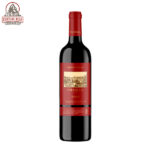Dolcetto
Dolcetto [dolˈtʃetto] is a black Italian wine grape variety widely grown in the Piedmont region of northwest Italy. The Italian word dolcetto means “little sweet one”, but it is not certain that the name originally carried any reference to the grape’s sugar levels: it is possible that it derives from the name of the hills where the vine is cultivated. In any case the wines produced are nearly always dry. They can be tannic and fruity with moderate, or decidedly low, levels of acidity and are typically meant to be consumed within a few years after release.
Most Dolcetto is found in the Piedmont region of northwest Italy, where many of the top estates produce Dolcetto on less favored sites as an “early to market wine” to generate some income for the winery while the Nebbiolo and Barbera are being matured. It is particularly associated with the towns of Dogliani and Diano d’Alba in the province of Cuneo, although the greatest volumes come from around Alba and Ovada. The grape is also found in Liguria under the name Ormeasco, and in the Oltrepò Pavese where it is called Nebbiolo or Nibièu.
Dolcetto wines are known for black cherry and licorice with some prune flavors, and a characteristically bitter finish reminiscent of almonds. While the name implies sweetness, the wines are normally dry. The tannic nature of the grape contributes to a characteristic bitter finish. The dark purple skin of Dolcetto grapes have high amounts of anthocyanins, which require only a short maceration time with the skin to produce a dark-colored wine. The amount of skin contact affects the resulting tannin levels in the wine, with most winemakers preferring to limit maceration time to as short as possible. During fermentation, the wine is prone to the wine fault of reduction.
Synonyms and homonyms
Acqui, Barbirono, Bathiolin, Batialin, Beina, Bignola, Bignona, Bignonia, Bignonina, Bourdon Noir, Cassolo, Charbonneau, Charbono, Chasselas Noir, Cote Rouge Merille, Crete de Coq, Debili Rifosk, Dolcedo Rotstieliger, Dolceto, Dolcetta Nera, Dolcetto A Raspe Verde, Dolcetto A Raspo Rosso, Dolcetto Nero, Dolcetto Piemontese, Dolchetto, Dolcino Nero, Dolciut, Dolsin, Dolsin Raro, Dolzin, Dolzino, Dosset, Gros Noir de Montelimar, Gros Plant, Maennlicher Refosco, Mauvais Noir, Montelimar, Monteuse, Montmelian, Mosciolino, Nebbiolo (dialect Nibièu, in the Tortonese and the hills of the Oltrepò Pavese[10])Nera Dolce, Nibio, Noirin D’Espagne, Nord Du Lot Et Garonne, Ocanette, Orincasca, Ormeasca (at Ormea and Pieve di Teco[10]), Ormeasco (Liguria), Picot Rouge, Plant de Calarin, Plant de Chapareillan, Plant de Moirans, Plant de Montmelian, Plant de Provence, Plant de Savoie, Plant de Turin, Plant du Roi, Premasto, Primaticcio, Primitivo Nero, Promotico, Provençal, Ravanellino, Refork, Refork Debeli, Refork Male, Refosk Debeli, Rotstieliger Dolcedo, Savoyard, Turin, Turino, Uva d’Acqui, Uva d’Acquia, Uva del Monferrato, Uva di Ovada, Uva di Roccagrimalda, and Dolsin Nero.
The Dolcetto di Boca, grown in the Novarese, is quite distinct while the rare Piedmontese Dolcetto bianco is an unrelated white grape
Showing the single result











